The most iconic Korean New Year’s food is tteokguk (떡국, rice cake soup)! It’s very common to add mandu (Korean dumplings), in which case the soup is called tteok-mandu-guk (or tteokmanduguk, 떡만두국). However, in the north (now North Korea), manduguk (or mandu guk, 만두국), which is made only with dumplings, is a New Year tradition.
Because the climate and land are not suitable to grow rice, this variation without rice cakes is popular in the north. Manduguk is the soup my husband grew up eating because his parents are originally from the north (prior to the division of Korea). They were among the millions who were separated from their families as they fled to the south during the Korean war (1950 – 1953).
Manduguk is a warming and comforting bowl of soup you can easily make at home!
I’ve already covered how to make tteok guk and tteok manduguk with beef broth. You can make mandu guk the same way using one of those recipes. In this updated manduguk post (originally posted in January 2011), I’ll show you some other variations (or ideas) so you can easily make a delicious dumpling soup at home.
Mandu (dumplings)
You can make manduguk with any variation of Korean dumplings, including pre-made store-bought ones. If you want to try making dumplings at home, try my kimchi mandu or classic mandu without kimchi. Homemade dumplings are totally worth the effort! Keep them in the freezer. They will come in handy when you want to make some warming, comforting soup.
For convenience, you can also use store-bought dumplings to make this soup. They usually come in frozen and most likely pre-cooked. You can simply add the frozen dumplings to boiling broth to make a soup.
Manduguk soup base
As mentioned above, beef broth is classic for this type of soup. In Korean homes, it’s also common to use milky beef bone broth, known as sagolguk (사골국), sagoltang (사골탕), or seolleongtang (설롱탕). I often make a large batch and freeze some for later use. It really makes a delicious soup base for many Korean soups such as this mandu guk. You can also find pre-cooked, commercially packaged milky bone broth at Korean markets or on-line.
Sometimes, I like to make this soup in a simple anchovy broth for a nice clean taste. Or, I simply grab store-bought chicken broth from the pantry to make a quick meal. Of course, you can use any type of your favorite store-bought broth.
For a vegan option, use vegan dumplings with vegetable broth.
For more Korean cooking inspirations, follow along on YouTube, Pinterest, Twitter, Facebook, and Instagram.
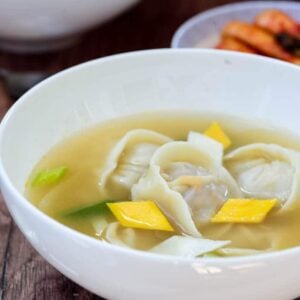
Ingredients
- 10 pieces mandu (dumplings) - adjust to your serving size See note 1
Broth:
- 5 cups chicken broth (or other flavorful broth such as beef broth, anchovy broth, vegetable broth, etc.) See note 2
- 1 tablespoon guk ganjang (soup soy sauce) or fish sauce (or omit and simply season with salt)
- Salt and pepper to taste
- 2 teaspoons minced garlic
- 1 scallion
Garnish (optional):
- 1 egg
- 1/2 sheet gim (김), seaweed sheet (aka laver, nori) roasted and crusted
Instructions
- In a medium size pot, add 5 cups of chicken broth (or broth of your choice). (See note below.) Bring it to a boil over medium high heat.
- Stir in the garlic, soy sauce, and salt and pepper to taste. Add the mandu pieces, stirring gently so they don’t stick to the bottom of the pot. Boil until all of them float, and reduce the heat to medium and boil for an additional minute or two.
- Slice the scallion into thin strips. Cut the thin egg omelette (see below) into strips and then into diamond shapes or roll it and slice into thin strips.
- Ladle the steaming soup into bowls and garnish with the scallion and optional egg jidan and/or gim.
How to make jidan - egg garnish (Optional)
- Beat the egg. You can separate the egg if you want and gently whisk each part. Heat a lightly oiled small nonstick skillet over medium heat and pour the egg mixture (or each egg part if separated) into a thin layer, tilting the skillet (similar to making crepe). Cook each side until no visible egg liquid remains. (Do not brown the egg.)
Notes
- Kimchi mandu is a popular choice for this soup, but you can use any type of dumplings for this soup, including pre-made store-bought dumplings.
- You can also use homemade beef broth, chicken broth, anchovy broth, vegetable broth, etc. as well as any of your favorite store-bought broth.


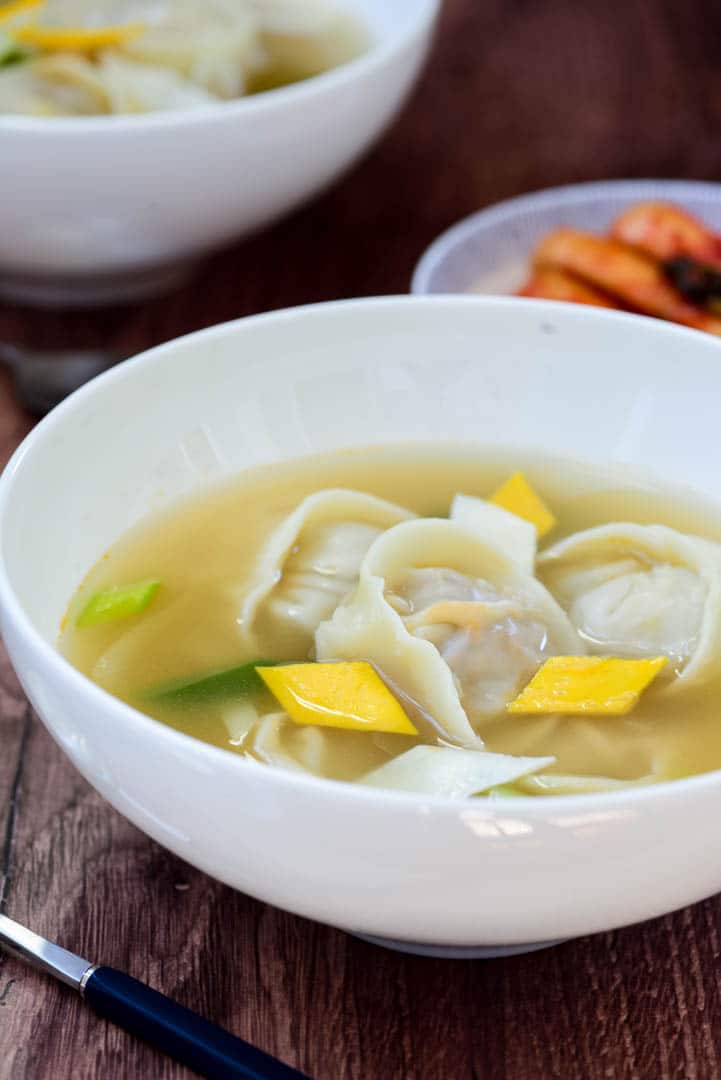
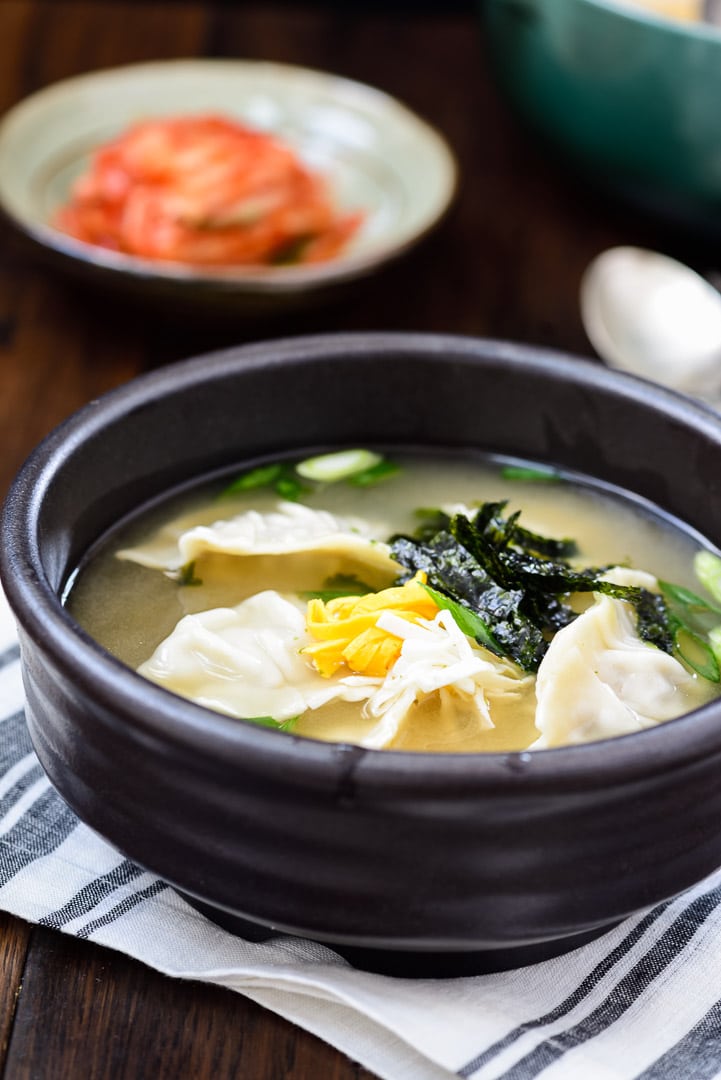
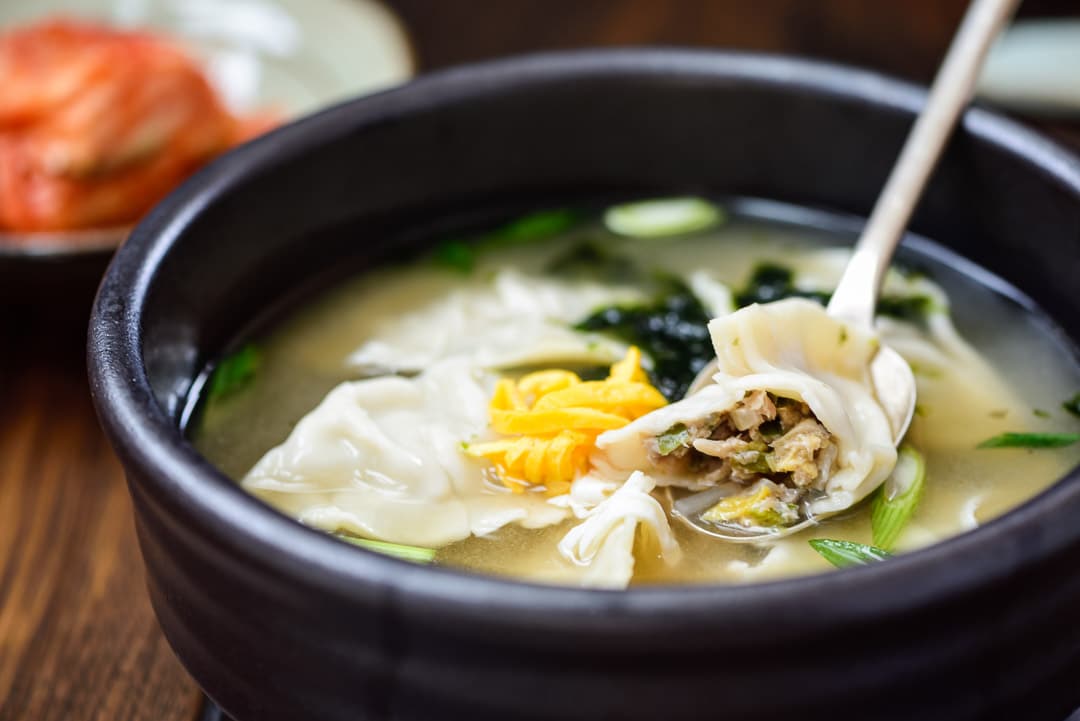
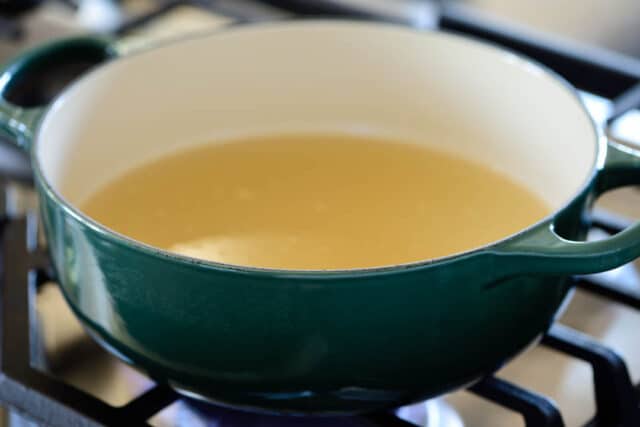
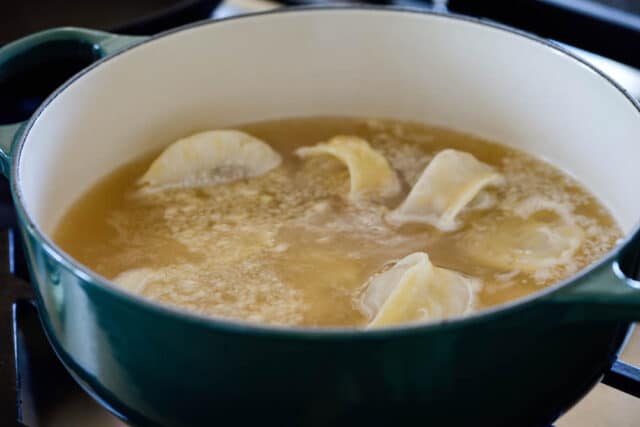
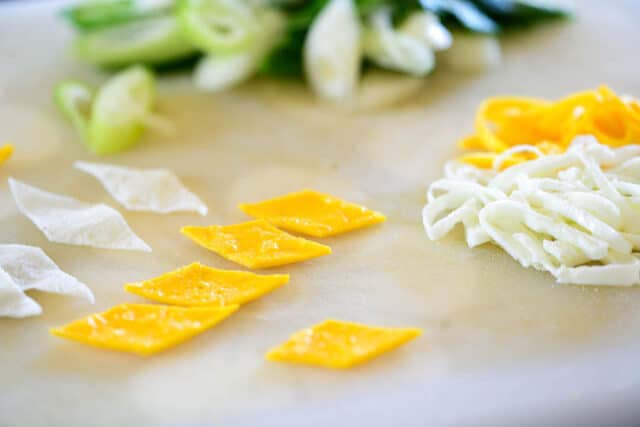
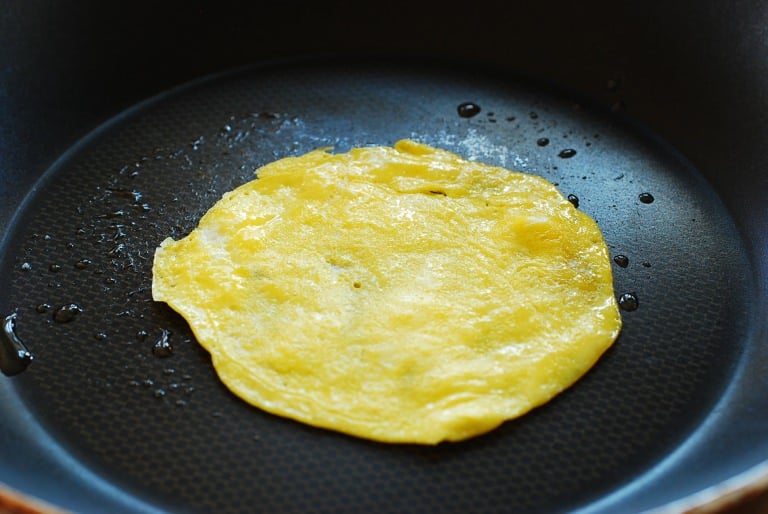
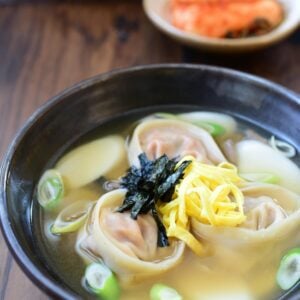
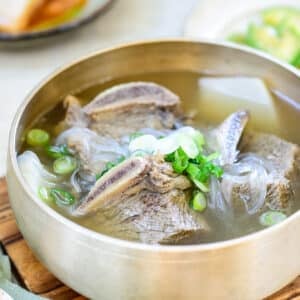
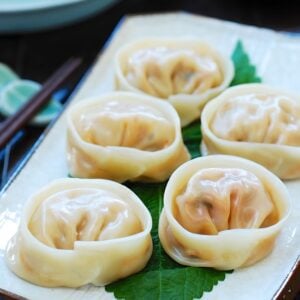
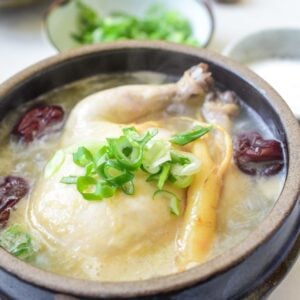










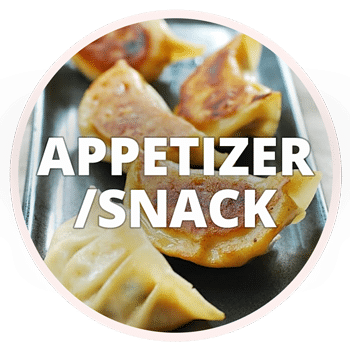
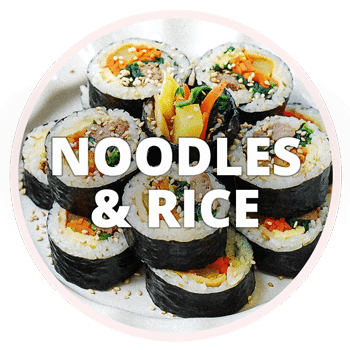
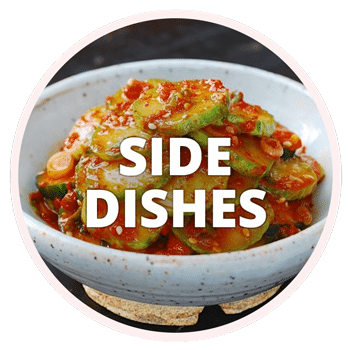

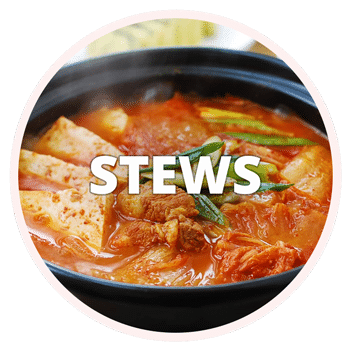


Autumn says
I made this tonight a absolutely delicuous! I added shiitake mushrooms and gochuchang (for a kick), but it would have been just fine without them. Quick, easy, and yummy. Thankyou!
Alice says
I’ve always wanted to cook Korean food for myself… thank you SO MUCH for posting all your delicious recipes here! I’ve been trying a new one every month, and it’s so good!
Hyosun says
You’re so welcome! I am very happy to hear you’re cooking Korean food using my recipes. Nothing makes me happier about my blog than hearing from the readers like you. Thanks, Alice!
Sandy says
Your recipes look great, however, it’s hard to follow them–even the simple recipes. Won Ton soup for example. I don’t know if I’m supposed the slice or dice the onion or leave it whole, the same for the garlic. Just to very clear.
Hyosun says
Sandy – sorry you find it hard to follow. For making stock or broth, you don’t need to cut the onion and garlic. That’s why I didn’t provide any instruction for cutting the vegetables.
Lauren says
Do I need to add anchovies
Hyosun says
You can use a different broth if you want. See here for a beef broth: https://www.koreanbapsang.com/2013/01/tteokguk-korean-rice-cake-soup.html
Deb Sistrunk says
I’ve been looking for a good recipe for this dish. I love this soup! Now I can make my own. This is my first visit to your blog. Great site!
Hyosun Ro says
Thank you! Welcome to my blog. Hope to see you often here.
ProChef360 says
You can’t go wrong with Korean food.
It is all the go in 2011
http://prochef360blog.com/koreaninspired-street-food-craze-food-trends-2011/
Matthew
Anna says
What a pretty picture, lovely….the soup looks delicious. Loved your site.
Judy says
Thank you for sharing a bit of history about the types of New Years soup which is specific to each region. I always enjoy learning about culture/history, just as much as I enjoy learning new recipes. I likely would like this Northern style soup better, as I love, love, love dumplings. 🙂
5 Star Foodie says
Those dumplings look picture perfect, beautifully made! And the anchovy broth sounds so flavorful and delicious!
Kitchen M says
It looks delicious! It reminds me of wonton soup, which is my favorite soup! But yours must be very different since it’s made with anchovy broth. It sounds great though. Thanks for the idea!
Biren @ Roti n Rice says
I had the rice cake slices in beef broth dish one New Year’s day at a Korean friend’s home. I like your version too with the kimchi mandu. Using napa cabbage and chives reminds me of Chinese dumplings which can also be cooked in broth.
denise @ quickies on the dinner table says
Oh my! I have a weakness for both soup and dumplings so this truly looks mouth watering to me! The picture of the soup is beautiful – it looks like it came from a food magazine!
Thanks for the background information on Korean dumplings and new year traditions.
A SPICY PERSPECTIVE says
What heavenly little dumplings! This soup looks utterly amazing!
~Lisa~ says
Love this! My fathers side is also from the North so my grandma used to love making dumplings.
Cubicle says
Wow that recipe looks great. Something I haven’t tried before…Thanks!
Tiffany says
It’s cold and icy in North Carolina… I would love a bowl of this soup!
happywhennothungry says
This soup looks so delicious and healthy too! Thanks for sharing the background information about this soup as well. I always love learning about new food cultures!
Sandra says
Oh that soup looks phenomenal! I love dumplings, and your photo is amazing!